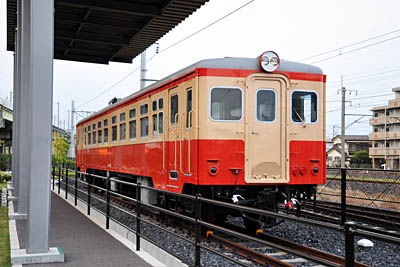
Diesel Car
Class
|
The first Japanese mass-produced standard diesel-car for branch lines. (Ki = Diesel (internal-combustion) Railcar , Ha = 3rd passenger class (later 2nd class) |

|
|
In postwar Japan, Japan's internal-combustion car development was started only to be interrupted by new diesel engine development.
This new diesel engine model DMH-17 was completed during February of 1951 and it was mounted on the Class KiHa-42000 No.42013. The working prototype of the Diesel-Electric model Series-KiHa44000 and the Hydraulic-Transmission system of the Series-KiHa44500 were made on the basis of the KiHa-42500 test results, before mass-production began during 1952-1953. During 1953, the production model design was completed, and one hundred were ordered by eight private rolling stock companies. They became the first Japanese mass-produced Hydraulic-Transmission system Diesel-railcars, and were named the Series-KiHa45000. The completed KiHa-45000s were tested on the Tokaido and Gotenba lines during May of 1954, and the test results were quite satisfactory. The first 100 of the Series-KiHa45000 were deployed as follows ;
The Series-KiHa45000 was manufactured in nine classes for a total of 728 cars up to 1956. During 1957, Series-KiHa45000 were renamed to the Series-KiHa10 Class KiHa-10, 11, 12, 16, 17, 18, 50 and 51 from the class name revision. The rest of the Series-KiHa10's were active on local lines throughout all of the country. In addition, they were partly used for express services. Their surplus weeding out began during 1973, and culling was accelerated after the heir model Series-40 diesel-car came on the scene. Most Series-KiHa10 were retired by 1981, and the last one was retired during 1984 from the JNR.
|
|
Preserved car KiHa-11 No.25 (1956 - 2004)
The Museum Class KiHa-11, her original class name was KiHa-48000. Class KiHa-48000 had two cabs and an added toilet version of the KiHa-45000. During 1955-1956, a total of 74 (No. 48000-48073) of Class KiHa-48000 were manufactured. Class KiHa-11 No.25 was manufactured at the Tokyu-Sharyo (Tokyu Car Co.) from the 8th of August 1956 as the KiHa-48035. She was renamed to the Class KiHa-11 No.25 during the year of 1957 from class name revision. After its inception, the KiHa11-25 was active mainly on the Moka line in Ibaragi prefecture. During April 1980, she was retired from JNR and sold to the Ibaragi-Kotsu Co. And it was renamed as the Ibaragi-Kotsu's KiHa-112. She was once retired during 1995, but was again revived as an event train during March of 1996 with JNR's original colors. During 2004, she was retired from Ibaragi-Kotsu and transferred and kept at the JR-East Koriyama General Rolling Stock Center. During 2007, she was remade and exhibited in the Museum. |
Introduction |
Go to Top |